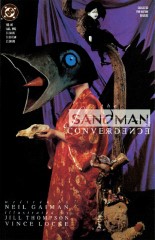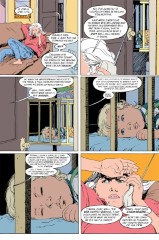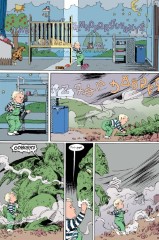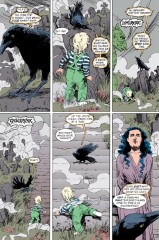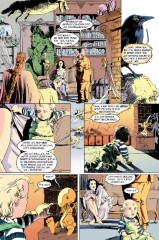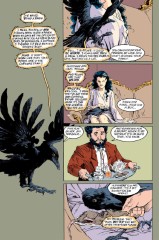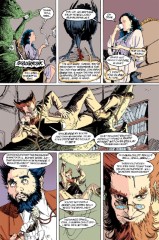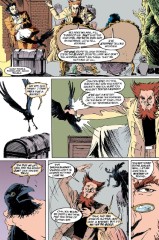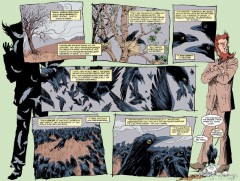Issue 40: "The Parliament of Rooks"
Neil Gaiman, Jill Thompson, and Vince Locke
- Third story in anthology, Convergences
- Eighth story reprinted in trade paperback Fables & Reflections
- Audible Act II Chapter 20
Themes: Convergences is about storytelling, as is Sandman overall. In particular, Convergences tells tales where the storyteller becomes the story, and where reality intersects with story and with fantasy. And, it may be noted, dreams are where reality and fiction converge.
A common thread among the stories is the intersection (or convergence) of characters with their own divergent lives. Another is the passage from the familiar to the unfamiliar, as happens to the central character in each story. Also, in each tale, the central character is not a native to the Dreaming but visits a portion of it in the process of the tale. One may also note the role of time in each tale, encompassing some aspect of the past, the present, and the future.
This issue is the most transparently about storytelling, with the "classical" DC storytellers Cain and Abel making an appearance.
Artist: There is a story about how Jill Thompson got the job. Sometimes CBG columnist Kim Metzger regularly has comic artists do sketches for him.
Last year he had Jill do him a sketch of Death, and then he sent a copy of it to Neil Gaiman. Neil was sufficiently impressed with the sketch that he offered Jill the opportunity of drawing a Sandman issue.
Page 1#
Panel 1
This is Lyta Hall, with her son Daniel. See Sandman #12. She is recounting the story of "Goldilocks and the Three Bears" in a somewhat bowdlerized version; compare to the version of "Little Red Riding Hood" Gilbert tells in The Doll's House.
The stylized rabbit doll on the couch is one of the characters in Purcell's "Sam and Max" series; Thompson is evidently a fan.
Panel 6
Lyta is financially secure, both on her own and through her late husband's estate. Thus, she doesn't need a job, and apparently doesn't get out much.
Page 2#
It may be worth noting that Lyta is still acting as a storyteller here, and that Daniel doesn't go to sleep till after she's been telling stories for a while.
Panel 1
Carla: Mentioned in #22.
Panel 4
Melrose: Melrose Avenue in LA. It is worth noting that LA was Lyta's old stomping grounds during the "Infinity Inc" days.
Panel 6
Get out of his crib: Irony.
Page 3#
Panel 1
Be sure to note that Daniel's body is still in the crib; it is his mental self which is out.
Panel 3
He is walking into the Dreaming; note that there are more than 26 letters in the alphabet.
Panel 4
This is Gregory the Gargoyle, as seen before.
Page 4#
Panel 1
This is Matthew the raven, of course; the "secret" to which he refers is the "House of Secrets" of which Abel is the caretaker.
As defined by Alan Moore in Swamp Thing, in the first major revision of Cain and Abel, a secret must be kept; Cain, of the "House of Mystery", dispenses mysteries which may be shared and pondered.
Panel 6
Dwell in nightmares: rings a bell; perhaps one of DC's mystery books?
Page 5#
Panel 2
It is important to ponder why Dream, whose realm appears to be second only to Delirium's in chaos, is intrinsically a maker of rules.
Panel 5
This is Abel.
Page 6#
Panel 1
Note the stuffed crocodile hanging from the ceiling. This is probably a reference to the corkindrill hanging from the ceiling of Merlin's cottage in T.H. White's The Sword in the Stone. (It is worth noting that Neil's buddy Terry Pratchett included a similar hanging crocodile in The Light Fantastic, a work which significantly preceded #40.) Note also the curiously carved walking stick, the mirror and skull, the crystal ball and fish bookend, and other decorations in the room.
Panel 3
Something Nasty in the Basement was first mentioned in Sandman #10. "Eyes too big for his": stomach completes the saying.
Page 7#
Panel 1-3
Corvidae: A family of birds including crows, ravens, and jays, of the suborder Oscines, containing songbirds with well-developed vocal organs.
Raven: Corvus corax, and similar species.
Crow: Corvus brachyrhynchos, et al. Jackdaw: Corvus monedula. Rook: Corvus frugilegus.
Magpie: Pica pica or P. nuttali.
From Baring-Gould and Baring-Gould, The Annotated Mother Goose (1962):
In most European countries, it is thought to be lucky to meet one magpie, raven, or crow:
One's lucky,
Two's unlucky,
Three is health,
Four is wealth,
Five is sickness
And six is death.
But in Maine, people say:
One crow sorrow,
Two crows joy,
Three crows a letter,
Four crows a boy.
Page 8#
Panel 2
A more explicit reference to Dream's love affair.
Page 9#
Panel 4
Vincent Price is a renowned actor in horror films, with a distinctive voice.
Panel 5
Cain obviously predates Price; note who does or does not sound like whom in his statement. "Old ham": Ham is a derogatory term for over-emotive actors; Price may be considered hammy by some.
Page 10-11#
A two-page spread. Cain's information on rooks is accurate.
Panel 3
Collective nouns: There exist long lists of collectives in various nodes of "triviaspace". Some are "official", and may be found in dictionaries, while some are the invention of the individual author.
Page 12#
Panel 3
Note the skeleton with hat in the background.
Pecked to death: Cain murders Abel over and over again.
Panel 6
In the Bible, the original Cain and Abel were indeed the sons of Eve (and Adam). Eve, in the Dreaming, represents archetypes:
"Everybody's mother", for example.
Page 13#
Panel 3
See the Appendix for the antecedents of Eve's tale.
Page 15#
Panel 1
Midrash: A collection of early Jewish interpretation and commentary on the Bible.
Page 16#
Panel 3
Nameless, Lilith, and Eve obviously form a maiden, mother, crone motif. Eve's commentary that the Lilim (-im is the plural indicator in Hebrew) have haunted the nights of the sons of Adam suggests that Lilith dwells in dreams, and is therefore this Eve. Eve's comment about Eve and her cave also suggests that she is this Eve as well.
The Lilim are more traditionally identified with succubi, demons that have sex with men as they dream and so drain them.
The story of Lilith and the Lilim is further expanded upon in Mike Carey's Lucifer spin-off.
Page 17#
Panel 1
Adam had three wives, but married only once: The truth of stories is not the cold analytical truth of the scientist's laboratory.
Adam married many women, for women have many aspects, but he married only once as well; that is the truth of this tale.
Panel 4
Note Daniel's skull (Matthew's rat's skull?), and the pictures on the wall behind. Is the one on the left Cubist? Are the others visual references to anything?
Panel 6
Wolf: A reference to Sandman #38?
Page 18#
Panel 4
This style of art bears some resemblance to Japanese SD or Super-Deformed style. Jill Thompson has done a picture of the Li'l Endless with all of the Endless in this junior form.
Panel 6
Remotely human: Cain and Abel are part of "the oldest story"; they and the Endless predate humanity. It is the nature of stories and storytellers to conform to their audience, however, as seen here.
Pablum: a trademark for a kind of infants' cereal (appropriate for Daniel, don't you think?), taken from pabulum (Latin for food), and often used derogatively to characterize something as having no substance.
Li'l: A contraction for "little", often used, as here, as a diminutive.
Page 19#
Panel 3
Death's invitation to Abel is because Abel is dead, of course.
Page 20#
Panel 1
The letters of commission were first seen in Sandman #2.
Panel 2
Note the appearance of the guardians of Dream's gate.
Page 21#
Panel 1
When stutterers are distracted from what they're saying, as Abel is when telling stories, their stutters often improve.
Panel 2
Matthew just doesn't get it.
Panel 3
Tom-tit, dicky-bird, and harrier are all sorts of birds.
Page 22#
Panel 4
The chess piece rook does come two to a player, four to a board. Chess is idealized battle. The rook's counting rhyme says "four for a boy". Eve is contemplating the apparent equation of male and fighting.
(Note that "rook" is from the Persian "rookh", warrior, and is only coincidentally the same spelling as the bird.)
Panel 5-7
There is irony in the acceptance of Abel's story and the secret of the Parliament of Rooks. (Note that the Parliament of Storytellers was split on Abel's story: Cain fell upon Abel and slew him, but the rest left the storyteller alone in the house.)
Page 23#
Panel 5-6
Cain is making reference to the fiction genre of mystery, often called "whodunnits".
Page 24#
Panel 1
Note the Vogue cover.
Panel 2
Note the cigarette pack in the ad.
Credits
- Originally collated and edited by Greg Morrow.
- Jim W Lai jwtlai@jeeves.waterloo.edu passed along a message from GEnie's TERRY.OBRIEN about Jill Thompson's art.
- The Theme Team consulted on the literary deconstruction of
Convergences, and consisted of:
- David "Pesky" Pautler (pautler@ils.nwu.edu)
- Lance "Squiddie" Smith (lsmith@cs.umn.edu)
- Enrique "Corporeal" Conty (jester@ihlpm.att.com)
- Chuck "Jones" Jordan (jordan@castor.cs.uga.edu)
- Andrew "Micky" Moran (andrew@cs.chalmers.se)
- Deborah "Ginchy" Ginsberg (debg@uxa.cso.uiuc.edu)
- Robert A. "Canny" Carlin (carlinra@ctrvax.vanderbilt.edu)
- Soren "Puzzling" Petersen (speterse@peruvian.utah.edu)
- Subrata Sircar (ssircar@canon.com) interpreted the Lilim as succubi.
- Lance Smith lsmith@cs.umn.edu noted Death's garden and added a note about Jill Thompson.
- Rick Jones albert@crick.ssctr.bcm.tmc.edu IDed Melrose Avenue, as did Tom Galloway (tyg@quip.eecs.umich.edu). Tom also embarrassed himself by misidentifying Eve's avatars as the hosts of The Witching Hour, but redeemed himself by recalled Eve's appearances in Plop!.
- Piers Cawley pdcawley@cix.compulink.co.uk IDed the stuffed crocodile.
- Colonel Sicherman (gls@windmill.ATT.COM) found the counting rhyme, gave the etymology of "rook", and saw a truthful cigarette ad.
- Carl Fink carlf@Panix.Com recalled Carla and the crocodile.
- Jim W Lai jwtlai@jeeves.uwaterloo.ca and Michael Bowman (bvmi@odin.cc.pdx.edu) did much research on Eve's tale, which is recounted in the Appendix.
Appendix: Concerning the Three Wives of Adam
Jim Lai writes: There are several sources for Eve's story, though mostly not in English. One of these is the Genesis Rabba, a midrash on the Book of Genesis compiled in the fifth century A.D. in Palestine. It also appears in the Babylonian Talmud, compiled circa 500 A.D., and a midrash on the Pentateuch, Tanhuma, compiled some time in the fourth century A.D. Those are among the earliest sources cited in Graves' book [see below].
Lilith was not a demon, though she later consorted with demons after leaving Adam. My reference for the more complete story is "Hebrew Myths: The Book of Genesis" by R. Graves with R. Patai. They in turn cite the Alpha Beta diBen Sira (a Midrashic text), "The Exempla of the Rabbis" edited by Gaster, and an issue of "Monatschrift fuur Geschichte und Wissenschaft des Judentums", but I digress. Lilith's offspring in the tale are the Lilim.
By one account, the Lilim were the half-demon offspring of Lilith, who were (initially) being born at the rate of over a hundred a day. From this we may infer that Lilith's appetite must have been prodigious. The Lilim are referred to, but not named, in panel 3 on page 14.
Another source says that the Lamiae "seduced sleeping men, sucked their blood and ate their flesh, as Lilith and her fellow-demonesses did..." The Lilim were said to haunt the nights, but not in such a metaphorical sense as dreams.
Michael Bowman writes: Lilith (in addition to what was in the issue): Either before or after she was parted from Adam, Lilith was Sammael's mistress [Samael is identified with Satan]; according to Islamic tradition she cohabited with the Devil and gave birth to the jinn. Traditionally, God dispatched three angels (Sanuy or Sennoi, Sansanui or Sansanvi or Sanvi or Sansennoi or Snvi or Sanzanuy, Samangaluf or Smnglf or Samangeloph) to induce Lilith to return to Adam before he created Eve, but she refused and thus incurred the penalty of losing 100 of her offspring each day. However, once more, after the expulsion from Eden, Lilith slept with Adam, and from this union were born the Shedim or evil spirits.
The Lilith of this story seems to be a development of the "maid of desolation" (ardat lili) of Babylonian tradition, a demon of waste places who originally lived in the garden of [the Sumerian goddess] Inanna. She became in Assyrian belief a wind spirit, wild-haired and winged. She has been incorrectly identified with the screech owl in the Bible (Isaih 34:14). The Talmudic tradition confused this spirit's name with the Hebrew name for night (laylah) and made Lilith a night demon, a succubus who slept with sleeping men and whose offspring from these unions were the demons. She attacked men sleeping alone; she thus was the angel of darkness and night and eventually a goddess (angel) of conception.
This belief became strengthened in the Middle Ages by the story of Adam and Lilith, to the point where Lilith was a Lamia-like creature who envied women their children (she had lost hers) and would take them unless prevented by specific charms. One of these charms invoked the three angels sent to bring her back to Adam. Children during their first week of life were most susceptible; girls especially were in danger until three weeks had passed; an amulet with the three names engraved on it would protect them. Or, a circle was drawn about the lying-in bed or somewhere in the room, with the charm "Sanuy, Sansanui, Samangaluf, Adam and Eve, barring Lilith." Or, amulets with a similar message were placed in several parts of the room. Similarly, four coins were placed on the marriage bed [like four rooks?], which was to say "Adam and Eve" and "Avaunt thee, Lilith!"
The rabbis read Lilith into Scripture as the first temptress, as Adam's demon wife, and as the mother of Cain. In Talmudic lore, as also in the kabala, most demons are mortal, but Lilith and two other notorious female spirits of evil (Naamah and Agrat bat Mahlat) will "continue to exist and plague man until the Messianic day, when God will finally extirpate uncleanliness and evil from the face of earth." In the Kabala, she is the demon of Friday and is represented as a naked woman whose body terminates in a serpent's tail. The first traceable mention of Lilith in Jewish literature is in a 10th century folk tale called the Alphabet of Ben Sira.
There are, of course, variations. Rabbi Eliezer (in The Book of Adam and Eve) says Lilith bore Adam 100 children every day. The Zohar describes Lilith as "hot fiery female who at first cohabited with man" but, when Eve was created, "fley to the cities of the sea coast," where she is "still trying to ensnare mankind." Some have said that Lilith and Sammael "emanated from beneath the throne of Divine Glory, the legs of which were somewhat shaken by their [joint] activity." It is known, of course, that Sammael was once a familiar figure in Heaven, but not that Lilith was up there also, assisting him.
Lilith went by a score of names, 17 of which she revealed to Elijah when she was forced to do so: Abeko, Abito, Amizo, Batna, Eilo, Ita, Izorpo, Kali, Kea, Kokos, Lilith, Odam, Partasah, Patrota, Podo, Satrina, Talto. Another list is: Abro, Abyzu, Ailo, Alu, Amiz, Amizu, Ardad Lili, Avitu, Bituah, Gallu, Gelou, 'Ik, 'Ils, Kalee, Kakash, Kema, Lamassu, Lilith, Partashah, Petrota, Pods, Raphi, Satrina(h), Thiltho, Zahriel, Zefonith.
The Nameless One: Well, I found an entry in Graves & Patai's Hebrew Myths which cited primary sources. Unfortunately, we don't have any of them (in English anyway). But, here's the complete entry from HM:
Undismayed by His failure to give Adam a suitable helpmeet, God tried again, and let him watch while he built up a woman's anatomy: using bones, tissues, muscles, blood and glandular secretions, then covering the whole with skin and adding tufts of hair in places. The sight caused Adam such disgust that even when this woman, the First Eve, stood there in her full beauty, he felt an invincible repugnance. God knew that He had failed once more, and took the First Eve away. Where she went, nobody knows for certain.
The language here, and in the entry on Lilith sounds a lot like that used in the comic. This was probably Gaiman's primary source. The information on Lilith as part of what I'd sent you a few days ago, Graves & Patai didn't include everything.
Last modified by Richard Munn on 2023-08-21 - Built another new plugin to better handle newlines in blockquotes, and removed manually inserted breaks
[edit this page] [page history]
